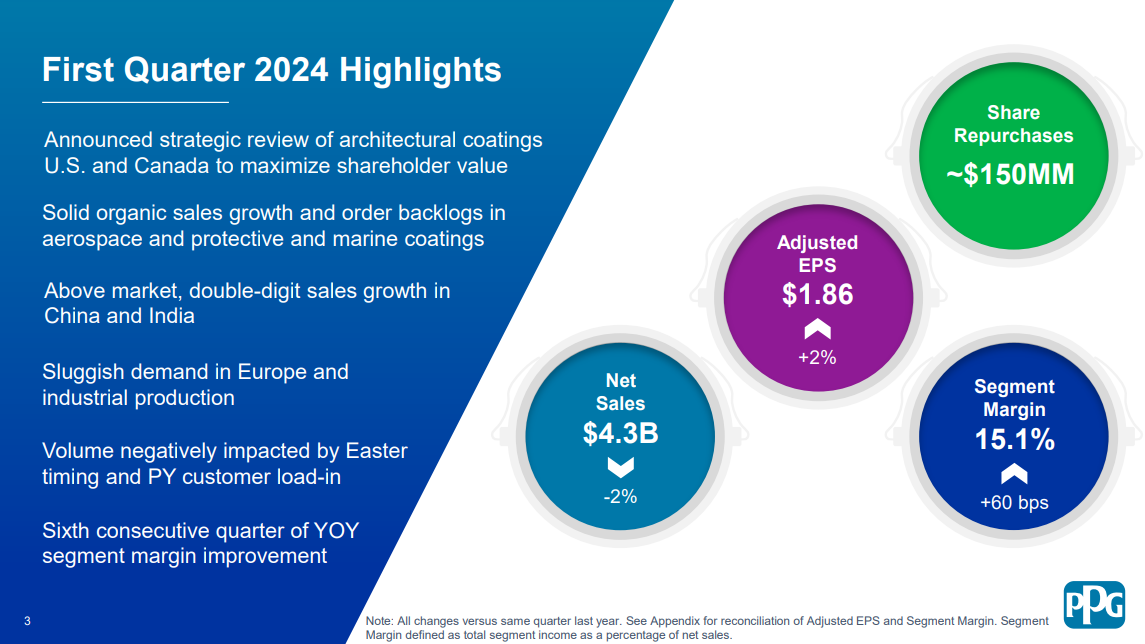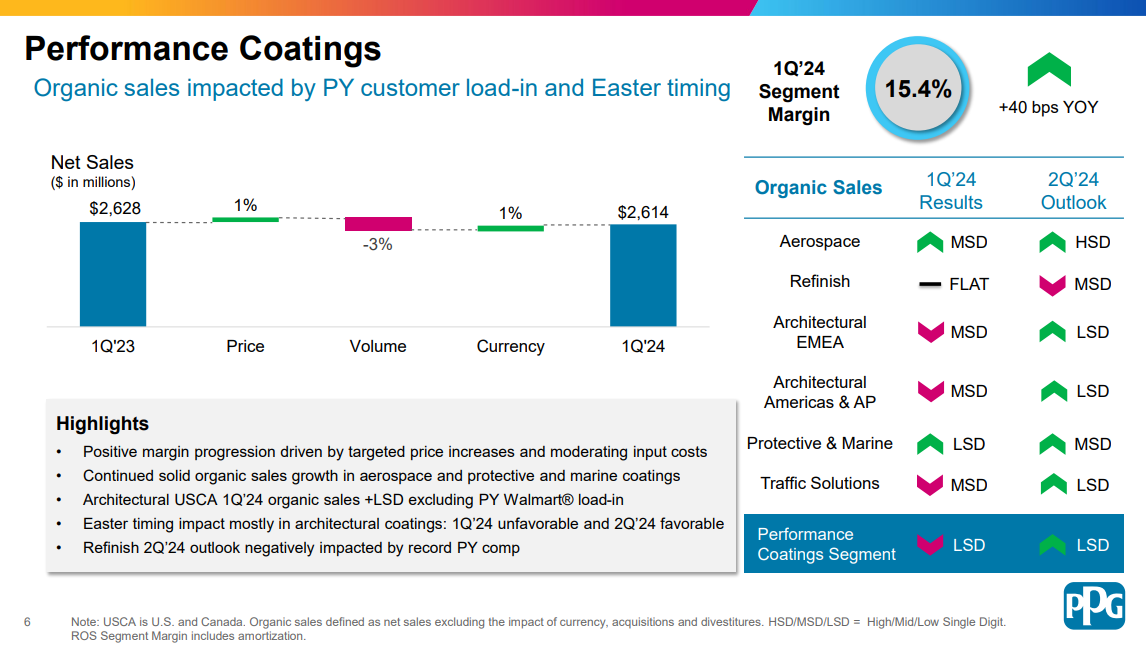Updated on April 23rd, 2024 by Bob Ciura
PPG Industries (PPG) is one of the largest paint companies in the world. It is also one of the most reliable dividend stocks in the market–PPG has paid dividends every quarter since 1899.
Moreover, the company has increased its dividend each year for the last 52 years, which qualifies it to be a member of the exclusive Dividend Aristocrats list.
This is a group of 68 stocks in the S&P 500 Index with at least 25 consecutive years of dividend growth.
We consider the Dividend Aristocrats to be among the elite dividend-paying companies. With this in mind, we created a full list of all 68Dividend Aristocrats.
You can download the entire Dividend Aristocrats list, with important financial metrics like dividend yields and P/E ratios, by clicking on the link below:
Disclaimer: Sure Dividend is not affiliated with S&P Global in any way. S&P Global owns and maintains The Dividend Aristocrats Index. The information in this article and downloadable spreadsheet is based on Sure Dividend’s own review, summary, and analysis of the S&P 500 Dividend Aristocrats ETF (NOBL) and other sources, and is meant to help individual investors better understand this ETF and the index upon which it is based. None of the information in this article or spreadsheet is official data from S&P Global. Consult S&P Global for official information.
The stock is also on the exclusive list of Dividend Kings.
PPG’s remarkable dividend consistency gives it broad appeal to the more conservative members of the dividend growth investing community.
Indeed, the company has a very safe dividend payment with room for steady dividend increases each year, thanks to its strong business model. This is still very much the case today.
This article will analyze PPG’s investment prospects in detail and determine whether the company merits a buy recommendation at current prices.
Business Overview
PPG Industries was originally founded in 1883 as a manufacturer and distributor of glass. PPG stands for Pittsburgh Plate Glass, which is a reference to the company’s original operations.
Over time, PPG has made remarkable strides in becoming an industry leader in the paints and coatings industry.
With annual revenues of about $18 billion, PPG’s only competitors of similar size are fellow Dividend Aristocrat Sherwin-Williams (SHW), as well as Dutch paint company Akzo Nobel (AKZOY).
PPG Industries has grown to such an impressive size thanks to its worldwide operating presence and focus on technology and innovation.
On April 18th, 2024, PPG Industries reported first-quarter financial results for the period ending March 31st, 2024. For the quarter, revenue decreased 1.6% to $4.31 billion, which was $120 million less than expected.
Source: Investor Presentation
Adjusted net income of $441 million, or $1.86 per share, compared to adjusted net income of $432 million, or $1.82 per share, in the prior year. Adjusted earnings-per-share were in-line with consensus estimates.
First quarter organic revenue growth was lower by 2%, or 1% when excluding a large customer purchase in the prior year. Performance Coatings revenue fell 1% to $2.61 billion. Higher selling prices (+1%) and favorable currency exchange (+1%) only partially offset a decline in volume (-3%).
As with prior quarters, Aerospace demand was robust, with organic sales up a mid-single-digit percentage. Protective and Marine coatings were up slightly while Automotive refinish coatings were flat. Revenue for Industrial Coatings fell 3% to $1.7 billion. V
PPG Industries also announced a share repurchase authorization of $2.5 billion, or roughly 8% of the company’s current market capitalization.
For the second quarter of 2024, PPG Industries expects organic sales growth in the low single-digits and adjusted earnings-per-share in a range of $2.42 to $2.52.
For 2024, the company expects organic sales to be higher by a low single-digit percentage and adjusted earnings-per-share in a range of $8.34 to $8.59. At the midpoint, this would represent a 10.4% increase from the prior year.
Growth Prospects
By and large, a company’s ability to increase revenues and profits is a function of its capital allocation.
PPG has spent billions of dollars in recent years buying its next generation of growth. It tries to maintain a somewhat balanced capital allocation strategy, but it is also not afraid to spend big on acquisitions when opportunities present themselves.
PPG has spent much more of its deployed cash on share repurchases than its competitors, which has been a major source of earnings-per-share growth over time.
Acquisitions have been a key growth driver for PPG for many years. That growth has come at a cost, namely an increase in the company’s debt.
PPG is now virtually exclusively a coatings business. The transformation in recent years away from legacy businesses like glass and chemicals has left the company with a portfolio of coatings products that collectively generate nearly $18 billion in annual revenue.
Source: Investor Presentation
Its track record suggests that its underlying business is likely to continue growing at a satisfactory rate for the foreseeable future. In the past decade, the company has grown its earnings-per-share at an average rate of just under 8%.
Given its very strong fundamentals and its focus on coatings, we believe investors can reasonably expect 8% adjusted earnings-per-share growth from PPG Industries through full economic cycles.
However, PPG’s performance is likely to suffer during periods of economic recession. The good news is that we would likely see such an event as a buying opportunity for this high-quality business.
Competitive Advantages & Recession Performance
PPG enjoys a number of competitive advantages. It operates in the paints & coatings industry, which is economically attractive for several reasons. First, these products have high-profit margins for manufacturers.
They also have low capital investment, which results in significant cash flow. PPG has put this significant cash flow to use over time, as discussed above.
Given all this, it makes sense that there are just two coatings companies (Sherwin-Williams and PPG Industries) on the Dividend Aristocrats list.
With that said, the paint and coatings industry is not very recession-resistant because it depends on healthy housing and construction markets. This impact can be seen in PPG’s performance during the 2007-2009 financial crisis:
- 2007 adjusted earnings-per-share: $2.52
- 2008 adjusted earnings-per-share: $1.63 (35% decline)
- 2009 adjusted earnings-per-share: $1.02 (37% decline)
- 2010 adjusted earnings-per-share: $2.32 (127% increase)
PPG’s adjusted earnings-per-share fell by more than 50% during the last major recession and took two years to recover.
As PPG’s 2020 results showed, the decline in new construction is the dominant factor for PPG during a recession. The 2020 recession was no different, as PPG faced factory shutdowns and severely reduced demand from consumers, although that proved to be transitory.
While the long-term prospects of this Dividend Aristocrat remain bright, investors should be willing to accept volatility in a recession.
Valuation & Expected Total Returns
We are forecasting earnings-per-share of $8.47 for the fiscal year of 2024, putting the price-to-earnings ratio at 15.3. This is below our fair value estimate of 19 times earnings, meaning PPG is undervalued today.
As such, we expect a 4.4% annual increase to total returns from valuation expansion in the next five years.
In total, we project that PPG will return 14.4% annually through 2029, stemming from 8% earnings growth and the starting yield of 2%, along with a 4.4% annualized return from an expanding P/E multiple.
Given this, we continue to rate PPG a buy.
Final Thoughts
PPG Industries has many of the characteristics of a very high-quality business. It has a proven business model and has generated strong growth over the past several years.
It also has a significant international presence and multiple catalysts for future growth. Lastly, it has increased its dividend for 52 years.
PPG’s dividend outlook is exemplary and we see many more years of dividend increases on the horizon. With expected annual returns above 14%, we rate PPG stock a buy.
If you are interested in finding high-quality dividend growth stocks suitable for long-term investment, the following Sure Dividend databases will be useful:
- The Dividend Achievers List: a group of stocks with 10+ years of consecutive dividend increases.
- The Dividend Kings List: considered to be the best-of-the-best among dividend growth stocks, the Dividend Kings are a group of exceptional dividend stocks with 50+ years of consecutive dividend increases.
- The Blue Chip Stocks List: contains stocks on either the Dividend Achievers, Dividend Aristocrats, or Dividend Kings list.
- The Monthly Dividend Stocks List: contains stocks that pay dividends each month, for 12 payments per year.
- The High Dividend Stocks List: high dividend stocks are suited for investors that need income now (as opposed to growth later) by listing stocks with 5%+ dividend yields.
The major domestic stock market indices are another solid resource for finding investment ideas. Sure Dividend compiles the following stock market databases and updates them monthly:


